This is a guest post contributed by Antonio Gabrić. Antonio is an outreach manager at Hunter. He is passionate about testing different outreach tactics and sharing results with the community. When he is not connecting with industry leaders you can find him on his motorbike exploring off-the-beaten paths around the world.
Having a steady stream of quality clients is vital for sustaining your business. But attracting your ideal client can be challenging in an increasingly crowded and competitive market, with 1.57 billion freelancers.
LinkedIn has become an invaluable platform for freelance networking, thought leadership, and lead generation. It boasts over 930 million users worldwide and serves just about every niche. By implementing strategic best practices, freelancers can optimize their LinkedIn presence to connect with prospective clients and grow their businesses.
This guide is full of actionable tips to help you stand out on LinkedIn, nurture professional relationships, create valuable content, and convert more leads into paying clients. Let’s dive in!
Optimizing Your LinkedIn Profile
You want to transform your profile into a place where clients know how you can help them achieve their goals.
Here is how to do it:
Craft a Client-Focused Headline
Your headline is one of the first things people notice on your LinkedIn profile — so make it count!
Summarize your freelance services in an attention-grabbing yet professional way. Make sure to include relevant keywords that prospects might search for to find you. Use persuasive language to indicate how you solve client problems.
Here is an awesome example:

David tells visitors three important things:
- What he does – “Senior Content Writer”
- Who he helps – “B2B & B2C” clients
- The outcome he provides – “grow your audience and get more leads”
The Power of a Persuasive Summary
While your headline hooks people, your summary section reels them in by persuading them to reach out.
Briefly share your career story, discuss the types of organizations you work with, and explain how you help clients reach their goals. Sprinkle in strategic keywords for greater visibility in LinkedIn search.
End by calling visitors to action — invite them to get in touch to discuss potential projects, or prompt them to visit your website, where they can view your portfolio and client case studies.
Here is a great example:
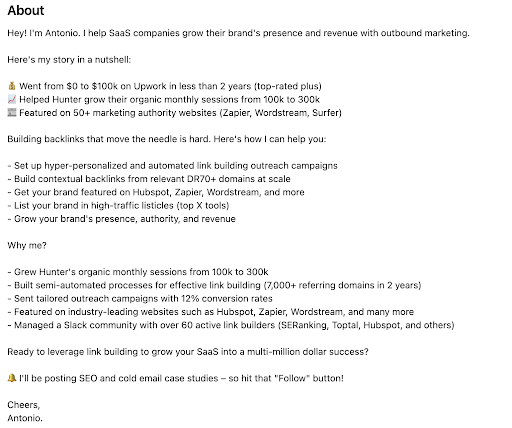
Antonio does everything mentioned but also adds quantified successes to outline his expertise.
Showcase Your Portfolio
One incredibly valuable yet often neglected aspect of LinkedIn is the Featured section where you can showcase examples of your best work.
Curate 3-5 pieces demonstrating your revelant expertise and the business impact you’ve delivered for real clients. Seeing tangible outcomes builds trust and credibility.
For example, if you’re an SEO specialist, add case studies from successful site optimization projects. If you’re a copywriter, share samples of your best writing.
Here is a cool example:
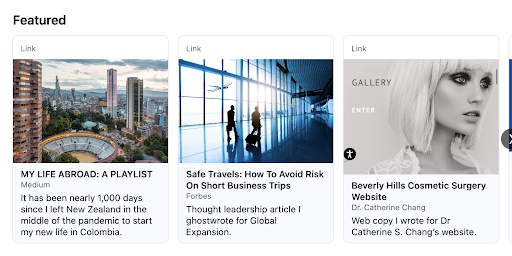
On this content writer profile, we can see:
- Personal blog
- Publication on a high authority website
- Client work
This balance is a great way to showcase the diversity of your skillset.
Building a Strategic Network
The average number of LinkedIn connections is 1,300. Your goal should be to grow the number of right connections.
Here is how to combine quality and quantity to build a strategic LinkedIn network:
Connect with the Right People
Quality beats quantity when building your network. Don’t just add strangers randomly — strategically identify relevant contacts instead.
You can search for potential clients by company, groups, job titles, and interests/skills using LinkedIn filters. Connecting with influencers in your industry also helps.
When sending connection requests, personalize them. Outline shared groups/interests you have in common, or explain why you want to connect with them.
Taking the extra minute or two to tailor requests makes a strong first impression and builds authentic relationships rather than appearing spammy.
Engage with Content
Actively engaging with content posted by your connections and influencers greatly expands your visibility on LinkedIn.
Comment on updates, share articles, and react to posts to enter conversations and join communities around your niche. This shows your expertise and credibility on the topics clients care about.
When sharing contentfrom others, always add original commentary providing your insight rather than simply reposting. This positions you as a thought leader.
Here’s a good example:
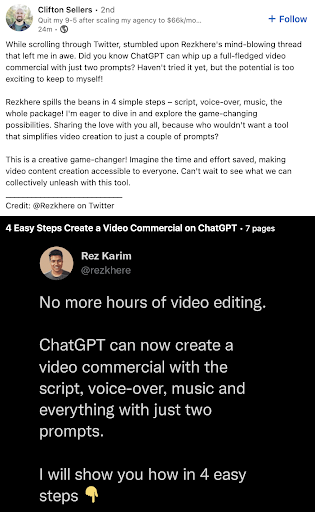
Utilize LinkedIn Groups
LinkedIn Groups support more focused networking and give you direct access to your target audiences, making them an ideal place to find clients.
You can find groups by typing in your desired niche and filtering for “Groups.”

Once in a group, start engaging by commenting on other people’s posts or creating a valuable post on your own. The idea is to do this consistently and avoid immediately pitching your services. Be helpful first, and freelance business leads will naturally follow.
Content Marketing on LinkedIn
Only 9 million LinkedIn users showcase their content, which is a great opportunity to start content marketing on your profile.
Create Valuable Content
The 5 most popular content types that attract clients on LinkedIn are:
- Carousels
- Blog posts
- Third-party content
- Native video
- Text only
- Photos and illustrations
Use them to create helpful content around pain points in a specific industry.
Here is an example of a thoughtful LinkedIn post:
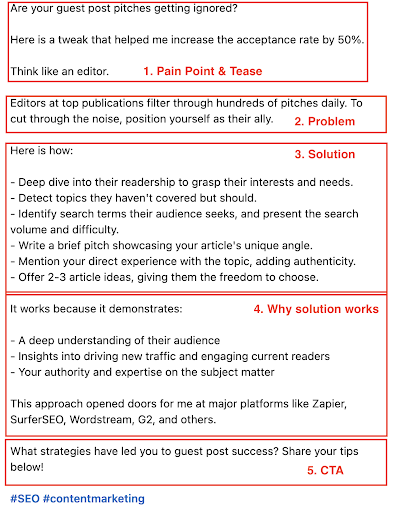
Most agree that the ideal LinkedIn publishing frequency is 2-5x/week, between 8 AM and 10 AM. Utilize this data to time your posts so you’ll get in front of more people.
Leverage LinkedIn Articles
While regular posts have great value, creating full-length articles for LinkedIn gives you more opportunity to showcase your skills and expertise.
The main benefit of publishing LinkedIn articles is the amount of flexibility you get with the higher word count.
Your articles can explore virtually anything relevant to your target audience, from inspiring stories and case studies to practical how-tos and guides.
LinkedIn Messaging Strategies
LinkedIn InMail has an impressive 18-25% response rate. Here is how to make the most of it.
Craft Compelling Messages
Organically attracting clients through your LinkedIn presence is only one part of the puzzle. The other part is reaching out to them directly.
With outreach, the key is to personalize your prospecting messages. You can do so by:
- Addressing prospects by name
- Opening with what initially interested you in their company, project, or post
- Asking questions to kickstart a conversation tailored to them
Here’s an example of a well-crafted personalized invitation:

Avoid vague invitations to connect or chat; intriguing opening lines spark better response rates.
Follow Up Without Being Pushy
You won’t get an immediate reply on every outreach attempt, and that’s part of the reason effective follow-up is crucial. But you want to avoid coming across as overly pushy.
Here are a few strategies to consider:
- Focus the message on the prospect’s pain point.
- Lead with value.
- Show interest in the prospect.
- Follow up multiple times, as this can double your response rates.
If LinkedIn outreach is still cold, it’s time to try email outreach. Most LinkedIn members don’t disclose their email addresses, so how do you find them?
With an email finder tool.
First, get a potential lead’s first name, last name, and company name from LinkedIn.
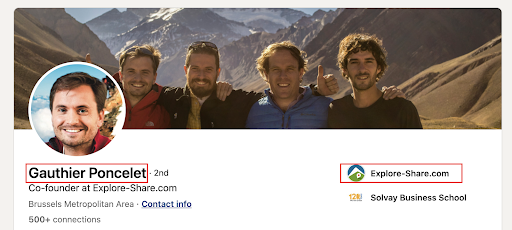
Then, plug this data into the tool. It will scrape the web and,Iin most cases, you’ll get the prospect’s email address. Then, you can attempt outreach again — but in a more direct way. Many people check LinkedIn infrequently, so don’t be shy about following up via email if you don’t hear them after a number of days.
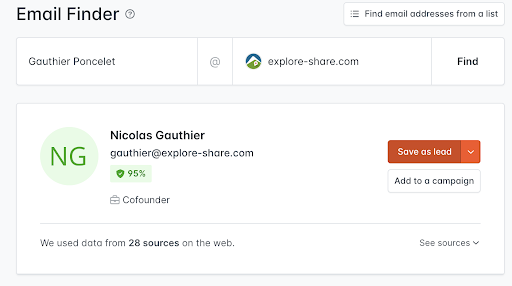
LinkedIn Analytics and Adjusting Strategies
You are 23 times more likely to attract clients if you implement data-driven decisions. Here’s what that means for your LinkedIn lead generation strategy.
Understand LinkedIn Analytics
LinkedIn Analytics provides insight into the activities and content that resonate most with your target audience.
Take note of these metrics:
- Follower growth rate
- Follower demographics
- Page views
- Engagement rate
These signals will indicate what content and activities are the most effective at attracting leads. Use analytics and feedback you get on your content or discussions to improve your lead generation strategy.
A/B Test on LinkedIn
To determine what works the best at attracting leads, test different variables, such as:
- Headlines – with numbers or questions?
- Call to action – direct or indirect?
- Images – stock images or original images?
- Text length – shorter or longer posts?
- Content type – carousel or text post?
Never stop experimenting — use the tools at your disposal to maximize success.
Advanced LinkedIn Strategies
Here are two bonus strategies that can help nudge along your client acquisition on LinkedIn.
LinkedIn Ads for Freelancers
There are 4 LinkedIn advertising options available:
- Sponsored Content
- Sponsored Messaging
- Dynamic Ads
- Text Ads
Sponsored Content and Sponsored Messaging are arguably the best for freelancers. They allow you to target decision-makers with your best content and reach out to them directly on LinkedIn
Using ads for LinkedIn is most effective when you know your target audience. Otherwise, it might be frustrating. Consider testing small monthly budgets to maintain steady visibility, and determine what kind of content and messaging has the highest ROI potential.
Once you get the hang of that, LinkedIn Ads can be a powerful lead magnet.
SEO for LinkedIn
Don’t ignore the power of SEO for LinkedIn — as 93% of B2B marketers use it for organic marketing. The first step is to optimize your profile for keywords your leads might search for.
Here is one easy way to do it: Use generative AI tools to help you with brainstorming keyword ideas.

Here is an example of the prompt in action:
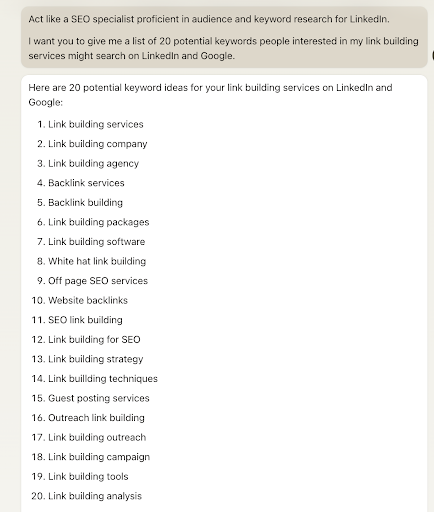
Once you have the keywords, you should use them in your profile headline, summary, and job history.
You can go even more granular too, weaving keywords into the content you post on LinkedIn. Don’t forget to provide genuine value though. It’s not all about the keywords, but they help you show up for certain searches.
Wrapping Up
LinkedIn isn’t just another social media platform — it’s one of the most pivotal channels for freelancers to network and convert high-value clients.
By optimizing your profile, creating client-centric content, strategically connecting, and utilizing a couple growth marketing strategies, you can leverage LinkedIn to secure your client pipeline.
Be intentional, get creative, and add real value. The effort you put into a thoughtful lead generation presence on LinkedIn can pay huge dividends for your freelance business.




